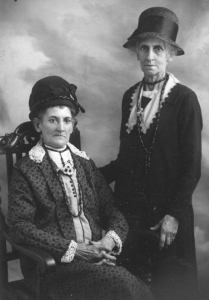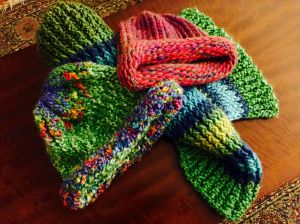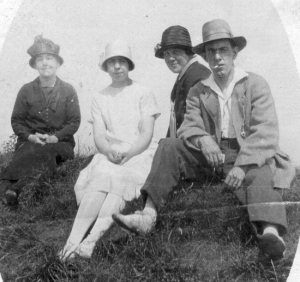Tags
Who shall I wear my hat at today?
I think it was easier in the old days. A woman’s hat announced to the world—or at least to the eagle eyes of her fellow women, which really was the same thing—just who and what she was. Change the hat; change the woman.
“Hats divide generally into three classes: offensive hats, defensive hats, and shrapnel” — Katharine Whitehorn
They say that in seven years, every cell of our skeleton has replaced itself. (Stanford Medicine). How often have you reinvented yourself, changed hats as it were? Today’s guest, Wendy Janes, has been thinking about this.
On such a cold winter morning, please grab a cup of coffee, one of these wonderful hats my sister makes, and sit over here with us by the fireplace while Wendy tells us about the difference a hat can make.
Wearing different hats
Guest Post by Wendy Janes
After my formal education ended, I read novels purely for pleasure, and my literary criticism extended no further than chats with family and friends about likes and dislikes of a particular book. Stories were for losing myself in. They could be an escape from, or a mirror on, the everyday. They were written by strangers whose skills at weaving magic with the written word I admired and enjoyed.
Then I was given the opportunity to review newly published novels for a magazine, and I needed to think more analytically about the books I was given to review; considering plot, characterisation, and style. While reading I might jot down some notes, which left me feeling slightly distanced from these stories. Whether reading for review or not, I found myself pondering more about the relationship between author and reader. What did the author want the reader to feel? What message (if any) was the author trying to get across? Was the author trying to educate, be the reader’s friend, unsettle the reader, and how effectively did he or she manage this?
 When I started work as a freelance proofreader I worked mainly on non-fiction titles. I was surprised at the extent of the differences between proofreading non-fiction and reading fiction for pleasure. The former required a thorough double-checking of sources, notes, references and bibliographies, and an in-depth analysis of elements of the text that most readers wouldn’t think twice about when curling up with their favourite book. For example, reading the imprint page, checking for a logical hierarchy of headings, and looking oh so carefully at the punctuation of quotes. All this, in addition to watching out for typos and questionable grammar. As well as an eagle eye, I found an emotional distance was required. Emotional distance was also required with the few fiction titles I proofread at that time. Getting carried away by a story wouldn’t help me do my job properly.
When I started work as a freelance proofreader I worked mainly on non-fiction titles. I was surprised at the extent of the differences between proofreading non-fiction and reading fiction for pleasure. The former required a thorough double-checking of sources, notes, references and bibliographies, and an in-depth analysis of elements of the text that most readers wouldn’t think twice about when curling up with their favourite book. For example, reading the imprint page, checking for a logical hierarchy of headings, and looking oh so carefully at the punctuation of quotes. All this, in addition to watching out for typos and questionable grammar. As well as an eagle eye, I found an emotional distance was required. Emotional distance was also required with the few fiction titles I proofread at that time. Getting carried away by a story wouldn’t help me do my job properly.
After a day of proofreading I’d look forward to unwinding with a novel. Removing my proofreader’s hat, I’d have to actively stop myself from hunting down errors and inconsistencies, and within in a chapter or two I could settle down to fully enjoy the story.
 After a decade of proofreading for publishers, I expanded my business and offered my services directly to authors. At that point it became more difficult to stop proofreading the books I read for pleasure. Spotting things such as inconsistent and incorrect hyphenation had become so ingrained, it took a serious act of will to try and stop noticing them and tutting every time an author used a spaced hyphen, or a mix of straight and curly quotes. Sometimes I wish I could go back to not noticing such things, but on the other hand, shouldn’t all books be as error free as possible?
After a decade of proofreading for publishers, I expanded my business and offered my services directly to authors. At that point it became more difficult to stop proofreading the books I read for pleasure. Spotting things such as inconsistent and incorrect hyphenation had become so ingrained, it took a serious act of will to try and stop noticing them and tutting every time an author used a spaced hyphen, or a mix of straight and curly quotes. Sometimes I wish I could go back to not noticing such things, but on the other hand, shouldn’t all books be as error free as possible?
I now write fiction myself. And my reading experience has shifted again. I often spot similar storylines and characters to my own. While reading a novel where the lead character suffers from post-natal depression, I wanted to tell the author that I had completed writing my as-yet unpublished short story about the same subject before I started reading her book. In the scene when the baby’s name is chosen without the mother being fully consulted, I was torn between admiration for how authentic that felt and annoyance that it was my idea in my short story. A case of great minds thinking alike, or an indication of a lack of imagination? I prefer to believe the former.
 My critical faculties have gone into overdrive. All too frequently I find I’m editing while reading, thinking that I would have used a different word or phrase, or written a different conclusion to a scene. Repeated phrases and words jump out at me, especially the ones I tend to overuse myself, such as ‘she smiled’ and ‘just’.
My critical faculties have gone into overdrive. All too frequently I find I’m editing while reading, thinking that I would have used a different word or phrase, or written a different conclusion to a scene. Repeated phrases and words jump out at me, especially the ones I tend to overuse myself, such as ‘she smiled’ and ‘just’.
I notice things that I struggle with in my own writing. For example, I sense when an author is frantically engineering the story to make a character behave in a certain way: there are too many leading questions and internal dialogue sounds strained or stilted. When I see this happening it feels like the bones of the plot are poking through. As a reader I don’t want to see the skeleton of the plot, it’s meant to be covered by the smooth skin of the storytelling.
There is a bit of me that enjoys the intellectual exercise of editing while reading for pleasure, but often I wish I could take off my author hat, feel the heart of a story and recapture the original romance of reading. However, it’s not completely lost. When I read a beautifully written book with a carefully crafted storyline that is so engaging or powerful that I suspend my critical faculties, then I know I’m reading something very special, and the romance returns.
Wendy Janes lives in London with her husband and youngest son. A number of her short stories have recently appeared in anthologies, and 2015 saw the launch of her first solo novel, What Jennifer Knows. Her writing is inspired by family, friends, and everyday events that only need a little twist to become entertaining fiction.
As well as writing contemporary fiction, she loves to read it too, and spreads
the word about good books online and in the real world.
Wendy is also a freelance proofreader, and a caseworker for The National Autistic Society’s Education Rights Service.
Note from Barb: Are you all still warm enough in those hats? Maybe it’s time to change them?
So how about you, coffee guests? How often do you change your reader hat? Do you tend to stick with one genre, move from one genre to another, or read across multiple genres? And how about you writers? Do you read the genre you write in?
Special News! Until 18 January, you can buy Wendy Janes’ critically acclaimed contemporary romance, What Jennifer Knows at the special sale price of £0.99.
What Jennifer Knows by Wendy Janes
 A vital member of her Surrey community, Jennifer Jacobs is dedicated to her job as a dance therapist, helping children with special needs to express themselves through movement. Wife of a successful though reclusive sculptor, Gerald, she is known for having a deep sense of empathy, making her a trusted confidante. So when two very different friends, Freya and Abi, both share information with her that at first seems to be an awkward coincidence, she doesn’t tell them. But as the weeks roll by, the link revealed between the two women begins to escalate into a full-blown moral dilemma – and also brings to the surface a painful memory Jennifer believed she had long since forgotten. What is the right thing to do? Should she speak out or is the truth better left unsaid?
A vital member of her Surrey community, Jennifer Jacobs is dedicated to her job as a dance therapist, helping children with special needs to express themselves through movement. Wife of a successful though reclusive sculptor, Gerald, she is known for having a deep sense of empathy, making her a trusted confidante. So when two very different friends, Freya and Abi, both share information with her that at first seems to be an awkward coincidence, she doesn’t tell them. But as the weeks roll by, the link revealed between the two women begins to escalate into a full-blown moral dilemma – and also brings to the surface a painful memory Jennifer believed she had long since forgotten. What is the right thing to do? Should she speak out or is the truth better left unsaid?
Contact and Buy Links
Amazon US | Amazon UK | Facebook Author Page | Facebook Profile | Goodreads | Twitter
Discover more from Barb Taub
Subscribe to get the latest posts sent to your email.





I really enjoyed this Wendy and Barb. I found once I started writing I became much more critical when reading but also considerable more appreciative of a well turned phrase or a seamless plot. I write romance but like mine with a hefty dose of thrilling action and adventure so I guess the fact I prefer to read gritty thrillers and crime will come as no surprise.
And thank you for the reminder on the offer on your book, I’ve just downloaded it :-)
LikeLiked by 1 person
Lovely to hear you enjoyed the post, Georgia. Yes, becoming more critical does have its upside when we find those gems. Thank you for downloading the book. Hope you enjoy it. Not a huge amount of grit or crime in my tale from the Surrey countryside. :)
LikeLiked by 1 person
I read all sorts Wendy and as I also write my stuff in the English countryside it will be lovely to see another view of it :-)
LikeLiked by 1 person
Excellent. Hope you enjoy meeting the inhabitants of leafy Larksmill.
LikeLike
Great post, ladies. It’s hard now to read as a reader and just immerse myself in a good story. Not one of the perks of being published…
I love all the hats, especially the ones in your header, Barb!
LikeLiked by 1 person
Thanks, Linda. Yes, those hats in the header look so cosy! I could do with one today.
LikeLiked by 1 person
I have a sister who knits. A lot. And (since she lives in Southern California) she doesn’t have a lot of customers locally. So I’m the lucky beneficiary of an amazing wardrobe of hat coziness.
LikeLiked by 1 person
I found an amazing owl hat pattern on FB the other day, she might like that! http://julieiscocoandcocoa.com/knit-owl-hat/
LikeLiked by 1 person
Oh, that’s adorable. Mary, what do you think?
LikeLiked by 1 person
Super cute … not sure I can pull off such a tasteful hat though …
LikeLike
I was interested to read the post. I’m not a writer, just a humble blogger, but I nevertheless do recognize the tendency to read other texts as though I were proofreading them. I actually find it a bit annoying. I’m not even that good at proofreading!
LikeLiked by 1 person
Yes, I can relate to feeling a bit annoyed to find myself proofreading something when all I want to do is sit back and enjoy it. I’ve just hopped over to your blog (thanks for the note about pronunciation!) – love the bathroom tiles post. Looking forward to reading more on your blog next week.
LikeLiked by 1 person
LikeLiked by 1 person
I hope the teachers then send back corrected versions for a final check. :)
LikeLiked by 1 person
I enjoyed reading this, Wendy and Barb. I sometimes think, as a reader I should be more analytical about what I’m reading. Most of the time, unless something jumps out and really annoys me, I’m immersed in the story and pass over things which would probably be glaring errors to an author.
LikeLiked by 1 person
So pleased you enjoyed the post, Cathy. I love that feeling of being immersed in a story.
LikeLiked by 1 person
As a reviewer and a writer, I just CAN NOT ignore most errors. I’m not sure if that means I’m incapable of fully enjoying a book, or if reading critically for structural as well as grammatical errors is part of the enjoyment.
LikeLiked by 1 person
I’m not a writer, but I do have times when errors grate. I think writers do look at things from a slightly different perspective and are more analytical, but for me other factors come into play; how much I’m enjoying the story, if there are lots of errors or if the author obviously hasn’t used a proofreader.
LikeLike
It does depend on the error, to me. Sometimes a perfectly irrelevant typo can spoil a book badly. For example, in the otherwise quite interesting Sybil Exposed (about the controversial multiple-personality disorder claim) Debbie Nathan has a casual mention about Kalamazoo, Michigan, being about a hundred miles east of Ann Arbor. Ann Arbor’s on the east end of the state, and Kalamazoo the west, and a hundred miles east of Ann Arbor is Ontario. It’s the sort of mistake everyone makes, and it’s an embarrassing but irrelevant oversight that nobody editing caught it. But it hurts out of proportion for that.
LikeLiked by 1 person
I’d give indie or self-pub writers a bit more wiggle room on this one. It’s incredibly expensive and difficult to manage rounds of editing, and almost impossible to self-edit. But for traditional published books that have (presumably) gone through in-house professional edits, there really is no excuse.
Still, every writer I know can point to edit fails in their own published work. My rule of thumb is that if I come across three or more edit fails in the first chapter, and the writing isn’t so over-the-top amazing as to make me need to push on, I give up on the work. My time is just not worth the annoyance and frustration of reading such a badly edited piece.
Does that make me a shallow reader? Maybe. And maybe I miss out on some great work. But reading is, above all else, my favorite and best idea of fun (that doesn’t involve my husband or, perhaps, Daniel Craig…). So why would I waste my fun-time on things that annoy me?
LikeLike
I enjoyed this post, though it made me feel maybe I’m not analytical enough when reading. I’d be useless as a reviewer – much more of a “I realy enjoyed this book” without any of the because…
And I did really enjoy What Jennfer Knows. It’s my kind of book because it’s about people, people the reader comes to know very well.
LikeLiked by 1 person
Glad you enjoyed the post, Mary. Please don’t think I’m advocating for everyone needing to be analytical of other people’s writing. Some of us are naturally picky so n so’s!
Thank you for your lovely words about What Jennifer Knows.
LikeLiked by 1 person
I can’t wait to read “What Jennifer Knows”. I’ve got an enormous TBR pile, but I’ve bought it and it’s calling my name.
LikeLike
Oh, thank you, Barb. Hope you enjoy it when it reaches the top of your TBR pile!
LikeLiked by 1 person
Barb, thank you ever so much for inviting me for coffee, today. I love your sister’s hats and those Katherine Whitehorn quotes are brilliant.
LikeLiked by 1 person
Ever since I heard ” who shall I wear my hat at today?”, I’ve regretted that women don’t wear hats much anymore.
LikeLike
Many, many moons ago we wore hats at the secondary school I went to. A winter one made of some sort of stiff felt material, and a summer straw boater. I wasn’t keen on this at the time but I look back with a certain nostalgia.
LikeLiked by 1 person
When I was in elementary grades, the girls’ uniforms included what we called a beanie (it looked like one of those little caps that have propellers on the top, but sadly we didn’t get the propellers). We were SO jealous of the big girls in Grade 5 who got to exchange the despised beanie for a dashing beret. Sadly, we moved away before I ever achieved the beret.
LikeLike
Very Beautiful
LikeLiked by 1 person
Thank’s so much. My hat’s off to you!
LikeLike
Reblogged this on cicampbellblog and commented:
Love the idea of basing a regular blogpost on hats – either literal, literary or metaphorically.
What fun!
Today on Barb Taub’s blog, she has asked Wendy Janes along as her guest to talk about the different ‘hats’ she has worn and is currently wearing.
And, if you think I’m posting a lot about Wendy Janes these days, hold on to your own hat, I’m hoping to interview Wendy myself in a few days time. That’s what happens when a debut novel is as well received as ‘What Jennifer Knows’. Everyone wants to try on the author’s hat 👒
LikeLiked by 1 person
Thanks so much for the reblog, and also for your incredibly clever use of the hat metaphor! I can’t wait to read Wendy’s book (downloaded, but not yet started) and also your interview with her.
LikeLiked by 1 person
Thank you for reblogging, Christine. Really looking forward to our interview next week. Love the hat metaphor! Won’t attempt to top it… :)
LikeLike
Hi I stumbled across this blog from #Sundayblogshare. I’ve come to the conclusion that I much prefer reading blogs to writing them. This was an interesting post – it made me think back (a long way back) to when I chose English Literature as a then O Level subject at school. I had loved reading since being a young child but all the analysis and the what is the author/poet trying to say to the reader ruined books for me and I was so sorry I ever chose it as a subject. Glad to say I recovered once I’d left school and regained my love of reading.
LikeLiked by 2 people
So glad you stopped by. And you’re completely right. Sometimes it can take a long time to get over being ‘educated’ and get back to loving to learn.
LikeLiked by 2 people
Although there are some good teachers who can keep their pupils’ love of literature alive, it’s such a shame when teaching a subject saps the life out of it. I think the demands of the curriculum/ teaching to prepare students for exams has a lot to do with this. I’m so pleased to hear you regained your love of reading.
LikeLiked by 3 people
Hi Wendy. I have to admit it was a long time ago (1970’s) so I’m not sure what it would be like studying English Lit now. I tried studying Psychology twice as an adult learner as the subject fascinates me, but academically – no it wasn’t for me.
LikeLiked by 1 person
My own secondary school days were back in the 1970s, too. :) I guess there are some subjects that we want to learn more about, but we need to do it in our own way rather than through prescribed texts and essay writing.
LikeLiked by 1 person
Gone are the days when men used to wear fedoras and women had a selection of hats for each occassion. It was a classy look back in the day. Sometimes as a blogger we all need to wear a different hat at times, so try something new, or get new perspective.
LikeLiked by 2 people
I think you’d look very dashing in a fedora!
LikeLike
I find as a teacher, I ‘read’ far more critically…I’m always analysing style and assessing vocabulary. It was the same what at university….. I find it difficult to read for pleasure…or maybe the pleasure is in the analysis…great blog…got me thinking!
LikeLike
I agree, Carol, there’s great pleasure to be had in the analysis of texts. It’s so exciting to uncover layers of meaning in an author’s writing. Equally exciting are those instant moments when an author’s words touch my heart or my funny bone.
LikeLike
Oh, the frantic engineering of dialogue, etc, to make the character behave in a certain way…. arrrgh!
And as for ‘she smiled’ and ‘just’….. Wendy, perhaps we need the same self-help group!!!
Barb, I love the Katherine W hat remark!!! Wonderful.
Re reading critically – I think it’s one of the downsides of being a writer. You can’t just read, you’re always thinking ‘ouch, I’ve already read ‘ubiquitous’ twice in this chapter’, considering how you would have plotted the build up better, etc etc. We have to accept that’s who we are, I think. If a book is good, it doesn’t stop me enjoying it.
LikeLiked by 1 person
Terry, maybe we could call the self-help group, Just Smiling. :)
LikeLiked by 1 person
I wear a lot of hats because I’m an Aries and we love a hat. Nothing to do with writing, just saying!
LikeLiked by 1 person
Three cheers for the decorative hat, Julia. A warm and woolly one for me today, I think. :)
LikeLiked by 1 person